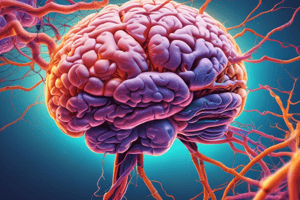Podcast
Questions and Answers
What elements can typically be found in the described books?
What elements can typically be found in the described books?
- Only text
- Text, images, and audio
- Text and images (correct)
- Only images
Which statement accurately reflects the focus of the provided content?
Which statement accurately reflects the focus of the provided content?
- The content highlights educational methodologies.
- The content emphasizes only paper materials.
- The content primarily discusses the importance of literary theory.
- The content presents images and descriptions of books and papers. (correct)
What type of visuals are primarily highlighted in the descriptions?
What type of visuals are primarily highlighted in the descriptions?
- Paintings and illustrations
- Close-ups of texts and images within books (correct)
- Photographs of people reading
- Charts and graphs
What is a common feature of the papers described?
What is a common feature of the papers described?
How are the books represented in terms of their content?
How are the books represented in terms of their content?
What type of close-up views are primarily featured?
What type of close-up views are primarily featured?
What can be inferred about the format of the books from the provided descriptions?
What can be inferred about the format of the books from the provided descriptions?
Which of the following most accurately describes the types of content shown in the images?
Which of the following most accurately describes the types of content shown in the images?
Flashcards
Printed Page
Printed Page
A sheet of paper with text or images that has been printed.
Book Pages
Book Pages
Individual sheets of paper that make up a book
Text on Paper
Text on Paper
Words or letters printed on a piece of paper.
Images on Paper
Images on Paper
Signup and view all the flashcards
Open Book
Open Book
Signup and view all the flashcards
Book Content
Book Content
Signup and view all the flashcards
Written Content
Written Content
Signup and view all the flashcards
Book Structure
Book Structure
Signup and view all the flashcards
Study Notes
Nervous System
- The brain controls thoughts, memories, speech, and movement.
- It also controls involuntary functions.
- Nerves carry messages to and from the brain.
- Motor nerves control the body's muscles (voluntary).
- Sensory nerves send messages to the brain about the environment, including the five senses.
Brain Stem
- Controls involuntary body functions like breathing, circulating blood, and digestion.
Cerebellum
- Controls balancing, coordination, and movement.
Spinal Cord
- Sends sensory and motor impulses to and from the brain.
Nervous System Diseases
- Alzheimer's disease is a brain disorder affecting memory and thinking.
- Cerebral palsy affects movement, muscle, and posture, caused by brain damage.
Studying That Suits You
Use AI to generate personalized quizzes and flashcards to suit your learning preferences.




